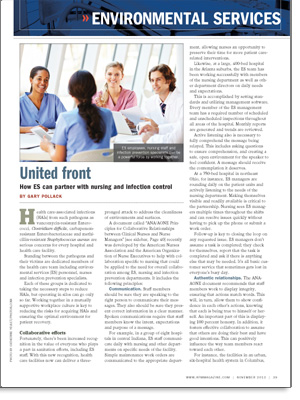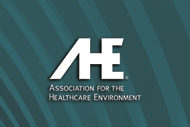
Health care-associated infections (HAIs) from such pathogens as vancomycin-resistant Enterococci, Clostridium difficile, carbapenem-resistant Enterobacteriaceae and methicillin-resistant Staphylococcus aureus are serious concerns for every hospital and health care facility.
Standing between the pathogens and their victims are dedicated members of the health care team including environmental services (ES) personnel, nurses and infection prevention specialists.
Each of these groups is dedicated to taking the necessary steps to reduce HAIs, but operating in silos can go only so far. Working together in a mutually supportive workplace culture is key to reducing the risks for acquiring HAIs and ensuring the optimal environment for patient recovery.
Collaborative efforts
Fortunately, there's been increased recognition in the value of everyone who plays a part in sanitation efforts, including ES staff. With this new recognition, health care facilities now can deliver a three-pronged attack to address the cleanliness of environments and surfaces.
A document called "ANA/AONE Principles for Collaborative Relationships between Clinical Nurses and Nurse Managers" [see sidebar, Page 40] recently was developed by the American Nurses Association and the American Organization of Nurse Executives to help with collaboration specific to nursing that could be applied to the need for overall collaboration among ES, nursing and infection prevention departments. It includes the following principles:
Communication. Staff members should be sure they are speaking to the right person to communicate their messages. They also should be sure they present correct information in a clear manner. Spoken communications require that staff members know the intent, expectations and purpose of a message.
For example, in a group of eight hospitals in central Indiana, ES staff communicate daily with nursing and other departments on specific needs of the facility. Simple maintenance work orders are communicated to the appropriate department, allowing nurses an opportunity to preserve their time for more patient care-related interventions.
Likewise, at a large, 400-bed hospital in the Atlanta suburbs, the ES team has been working successfully with members of the nursing department as well as other department directors on daily needs and expectations.
This is accomplished by setting standards and utilizing management software. Every member of the ES management team has a required number of scheduled and unscheduled inspections throughout all areas of the hospital. Monthly reports are generated and trends are reviewed.
Active listening also is necessary to fully comprehend the message being relayed. This includes asking questions to ensure comprehension, and creating a safe, open environment for the speaker to feel confident. A message should receive the contemplation it deserves.
At a 350-bed hospital in northeast Ohio, for instance, ES managers are rounding daily on the patient units and actively listening to the needs of the nursing department. Making themselves visible and readily available is critical to the partnership. Nursing sees ES managers multiple times throughout the shifts and can resolve issues quickly without having to pick up the phone or submit a work order.
Follow-up is key to closing the loop on any requested issue. ES managers don't assume a task is completed; they check for themselves, report that the task is completed and ask if there is anything else that may be needed. It's all basic customer service that sometimes gets lost in everyone's busy day.
Authentic relationships. The ANA-AONE document recommends that staff members work to display integrity, ensuring that actions match words. This will, in turn, allow them to show confidence in each other's actions, knowing that each is being true to himself or herself. An important part of this is displaying 100 percent honesty. In addition, it fosters effective collaboration to assume that others are doing their best and have good intentions. This can positively influence the way team members react toward each other.
For instance, the facilities in an urban, six-hospital health system in Columbus, Ohio, utilize sign-off sheets in areas like the surgery department. Nursing and surgical personnel must move patients through a surgery area like a well-oiled machine.
They do not need to worry about what goes on behind the scenes on the second and third shifts regarding terminal cleaning of the surgery suites. This tool lets nursing know that the room has been aseptically cleaned and is ready for the next procedure.
Staff members completing terminal cleaning are specialists who receive annual training that includes up-to-date standards and competency testing to ensure they fully understand the materials. The Columbus operation has more than 60 surgical suites that are terminally cleaned each evening. Everyone in the surgery department knows that if this important cog breaks down, the machine comes to a halt.
Likewise, a group of ES departments in Tacoma, Wash., are using an adenosine triphosphate (ATP) testing validation tool to ensure that all patient touch points are disinfected. They have been working with their hospital infection control and nursing departments according to Centers for Disease Control and Prevention recommendations to ensure that 80 percent of the touch points will pass their ATP monitor. If a patient room does not meet 80 percent compliance, the room is recleaned. Collaboration among ES, nursing and infection control ensures that everyone understands the established criteria.
As staff members develop these authentic relationships, they also can make outward changes that will show each staff member respect. One key is working to create a workplace in which all can feel free to share ideas and put them into action without fear of ridicule. They also should be honest about what they want, but willing to compromise for the good of others.
Learning environment and culture. In general, organizations should embrace changes that deliver a positive feeling when it comes to learning. This includes helping staff members to eliminate fear of failure. The hospital also should encourage innovative, creative thinking and problem-solving. Thought processes should be geared toward positive changes rather than maintaining the status quo.
A project in the Tacoma, Wash., area recently involved the training of more than 400 hourly ES employees at five hospitals. The associates watched up-to-date DVDs and online videos followed by competency testing and one-on-one training with an ES manager.
The materials covered everything from bloodborne pathogens to cleaning a public restroom. Customer service issues such as knocking before entering a room, and making sure staff do not put a task before a customer's needs were also covered.
Of course, a different approach is required when training management teams. In a recent continuing education class in Detroit, ES leaders were trained to run a positive working environment. Examples included posting positive comments from internal and external customers, tracking HCAHPS scores and following trends by area, thus helping staff to understand the important role they play in achieving the overall goal.
Staff members should develop and adhere to a regular improvement cycle. This involves evaluating actions and experiences, determining what areas can be improved and employing specific steps to make needed changes.
Leaders also should take time to openly recognize things that are done well. Genuine, sincere recognition is the No. 1 motivator with ES staff. Improved HCAHPS scores on specific units should be recognized in staff meetings and daily huddles.
Daily staff huddles prior to each shift at the suburban Atlanta hospital keep staff up-to-date on important issues. Monthly staff meetings focused on positive outcomes and scores create a positive work environment. Correction always should be done one-on-one.
Three in one
ES employees, nursing staff and infection prevention specialists can be a powerful force by working together to deliver excellent patient care with confidence in a clean, healthy environment. And evidence suggests that these groups are beginning to recognize the value they bring to reducing the risk of HAIs in health care facilities.
Intelligent collaborative efforts can make a positive difference in the lives of patients. For example, the working relationship of the three professional groups is exceptional at one hospital in Michigan. Infection control employees and representatives from nursing regularly attend ES staff meetings to assist in training and to emphasize the importance of the ES department's responsibilities and how they play a critical role in reducing HAIs.
The key is for ES personnel to realize that they are essential, unified professionals working together against the common enemy of HAIs. Each dedicated, well-trained group plays a vital role in supporting each other and defending patients against dangerous pathogens.
When hospital staff members see the true enemy, the differences among their internal professional groups seem insignificant by comparison.
Gary Pollack is a senior vice president of operations and environmental services with HHA Services, St. Clair Shores, Mich., an ABM company. He can be contacted at gpollack@hhaservices.com.
| Sidebar - Information on successful collaborations |
| The accompanying article was based on the outline set forth in the "ANA/AONE Principles for Collaborative Relationships between Clinical Nurses and Nurse Managers," which was developed by the American Nurses Association and the American Organization of Nurse Executives. It can be accessed at http://nursingworld.org/MainMenuCategories/ThePracticeofProfessionalNursing/NursingStandards/ANAPrinciples/Principles-of-Collaborative-Relationships.pdf. For more information on successful hospital collaborations, the author suggests the following resources: Webinars• "The Role of Environmental Surfaces in Disease Transmission": http://webinars.apic.org/session.php?id=9470 Videos• NYU Langone Medical Center collaboration success: www.youtube.com/watch?v=krMCiZYD8kc Templates and checklists• Infection Prevention and Control Committee Report for Environmental Services template: http://cleanspaces.site.apic.org/files/2012/02/Environmental-Services-Report-Template_2011.pdf |



